Don't you hate when your perfectly smoked chicken thighs have a tough, rubbery skin that ruins the dish? I do. I have an easy and perfect solution that will work 100%, and you will be very happy with the results. Yes, perfectly smoked chicken thighs, exceptionally flavorful and very juicy, with thin, crispy skin without even a hint of being rubbery. I love this smoked chicken thigh recipe.
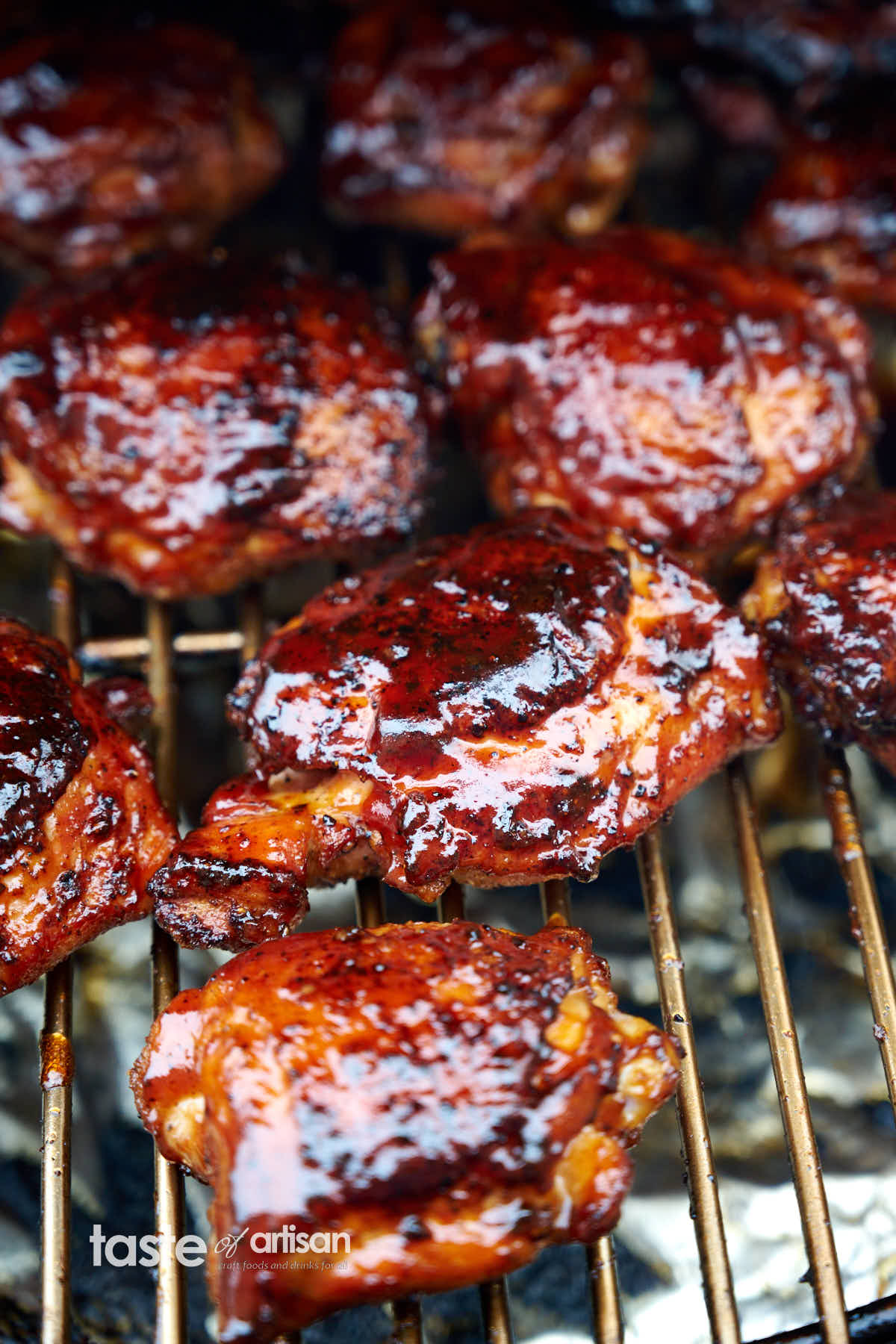
It's all thanks to pan-searing. Pan-searing will render most of the chicken skin fat out, leaving a thin, crispy, crackly skin. This skin is as good as it gets. I'd eat it right away. But I am jumping ahead; let's go step by step to make our perfect smoked chicken thighs that will be better than any competition smoked chicken thighs, I am sure of it. This is the same method I now use to make many chicken recipes - smoked chicken breasts, chicken leg quarters, and even oven-roasted chicken - it works exceptionally well.
This recipe works very well with boneless chicken thighs too, but the chicken must have skin to get the best results. You could use boneless chicken thighs, but they won't be as moist and juicy. Smoking boneless chicken thighs require a different method to get optimal results.
Smoked chicken thigh rub
Before we begin smoking chicken thighs, they need to be seasoned. I don't brine them, the meat will be very, very juicy, so there is no need to do that. Brining will help get the salt and the seasonings deep inside the meat, flavorizing it inside out. If that's what you are after, do it. Here is a very good chicken brine recipe that I use.
That said, if you just rub the meat with a simple chicken spice rub and let it sit for 30 minutes and up to 2 hours, that will make it very flavorful. You can even leave the chicken to sit in a fridge overnight, it will only get better. I avoid using sugary dry rubs in this recipe as it makes chicken skin burn during searing. If you want your chicken slightly sweeter, apply some brown sugar after searing or use a sweeter BBQ sauce later.
Pan-searing chicken before smoking
This step is what makes this smoked chicken so exceptionally good. Searing over medium-high heat renders off most of the fat, leaving behind a thin, golden-brown, crispy, and delicious skin. All the grease, chewiness, and rubberiness are gone. This method produces the best results for me when smoking skin-on chicken. It also makes chicken thighs healthier and with fewer calories as most of the skin fat will be removed. This step is what elevates smoked chicken meat to the next level. Once you try it, it will be an essential part of your chicken smoking process.
A cast iron pan is what I use for searing chicken, it works very well, but any pan will do. You can even do the pan-searing on a non-stick pan on an electric stove, it will work fine.
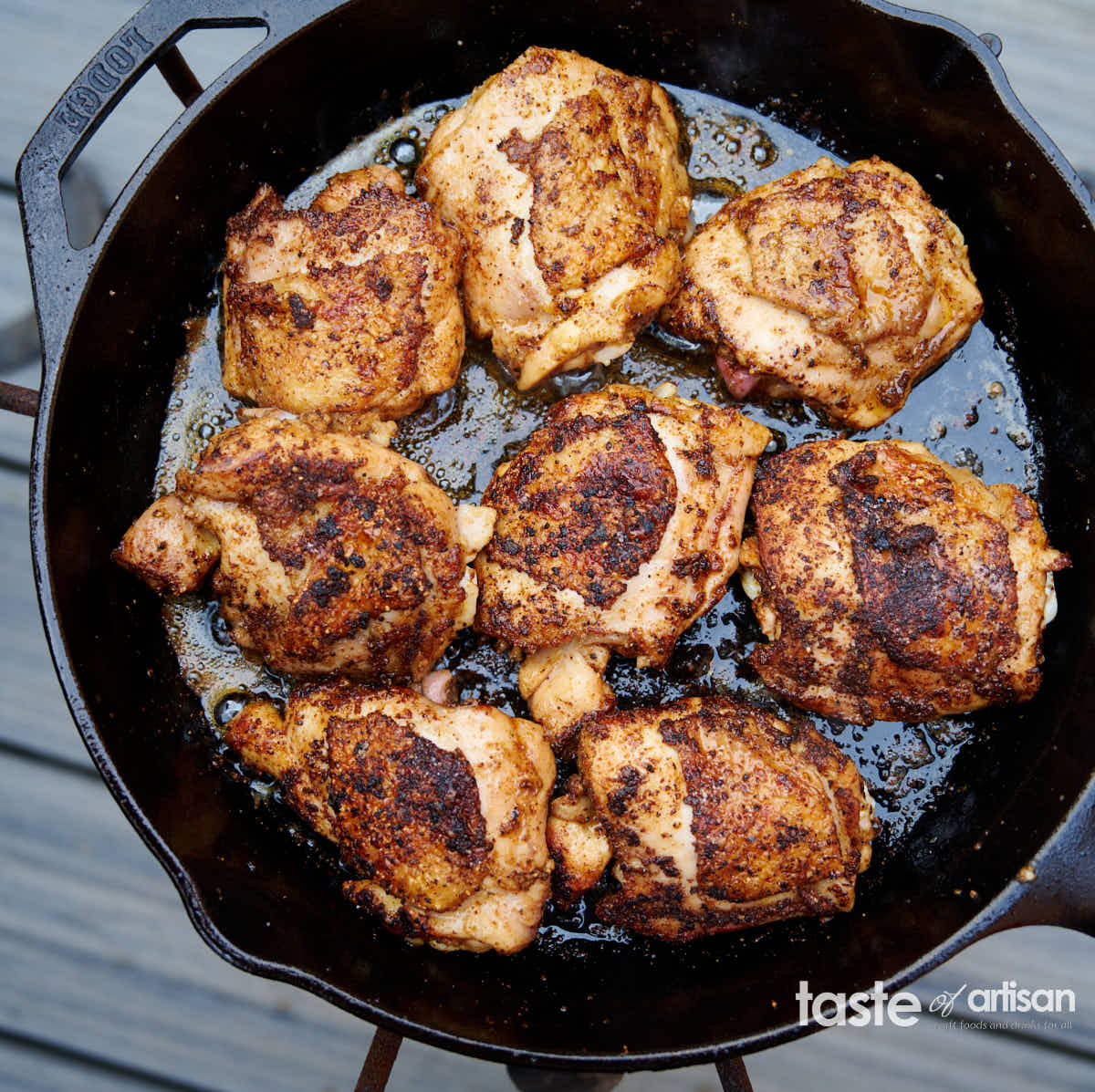
Smoking chicken
Fire up your smoker - offset smokers, pellet grills like Traeger, Big Green Egg, and kettle grills work well for this recipe - and preheat it to about 250F - 275F.
I find that I get the best results when smoking chicken thighs at around 250F - 275F at the grate level over indirect heat. When smoking at this temperature, I get the best meat texture. Higher than that - the chicken will cook too fast, resulting in insufficient smokiness. Lower than that - the chicken thighs will have a texture that almost feels undercooked. Of course, this is a matter of personal taste. If you prefer to smoke your chicken at a lower or higher temperature, go for it.
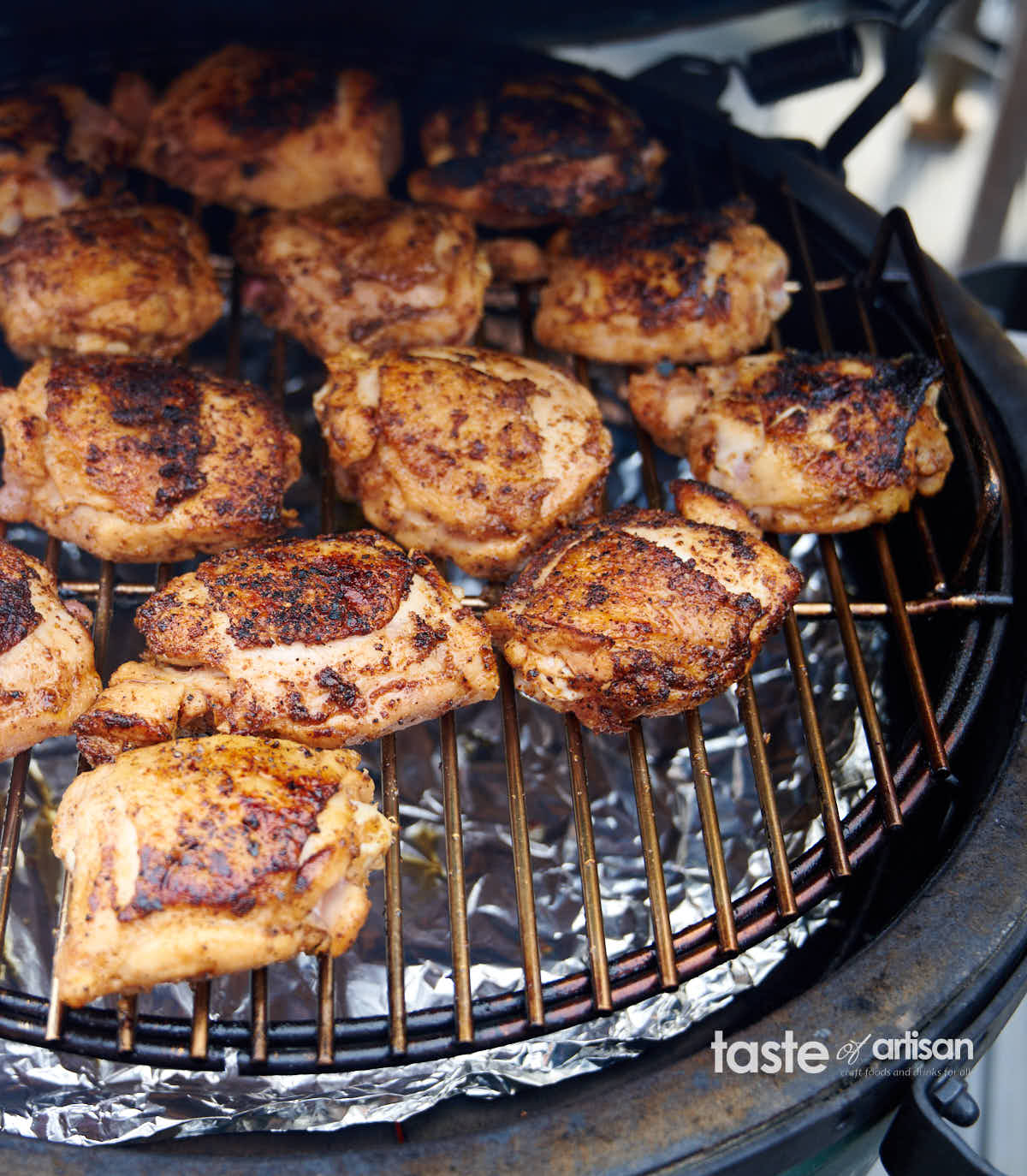
Depending on the temperature, the chicken will be done after about an hour to an hour and a half. That's plenty of cooking time to make it decently smoky. Of course, you want to use wood that has strong enough flavor, like oak, hickory, or cherry. Even pecan. Don't use apple, pear, or maple... those are very weak, and it may take a long time for the chicken to get decent smokiness with those.
The chicken is done with it reaches 185F to 190F internal temperature. Lower internal temperature makes dark chicken meat taste undercooked. Higher - will dry out the meat. Use a meat thermometer to help you check the temperature. Better yet, use a good BBQ thermometer which will alert you when the target temperature is reached.
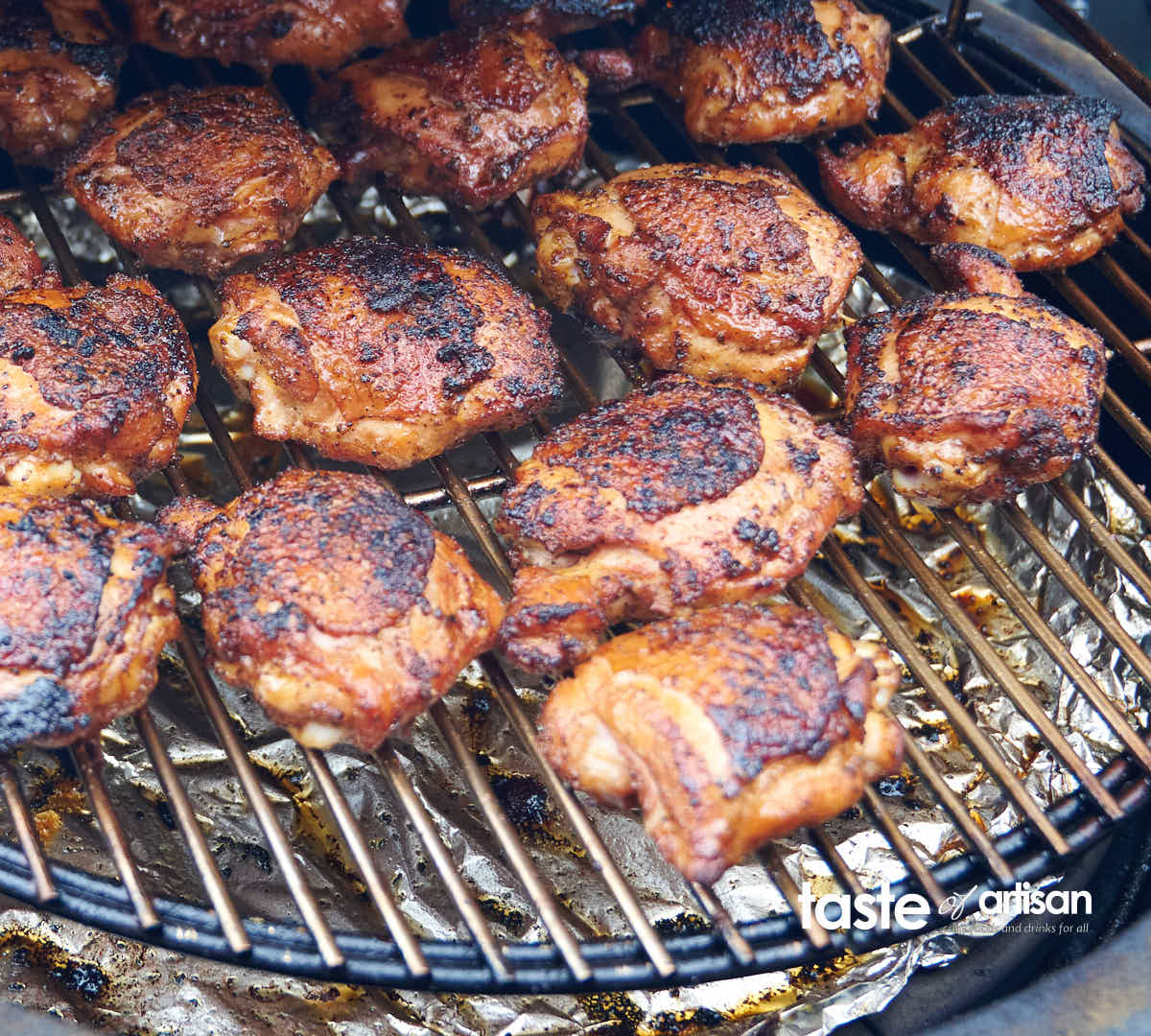
Applying BBQ sauce
This step may be omitted, the chicken will be fantastic without it, but it will be even better if you apply some BBQ sauce to it. Just before the chicken is done, glaze it with your favorite BBQ sauce and let it smoke for another 15 minutes or so to let the sauce thicken a little. This is it, the chicken is ready. I like Duff's BBQ sauce in this recipe, it's delicious.
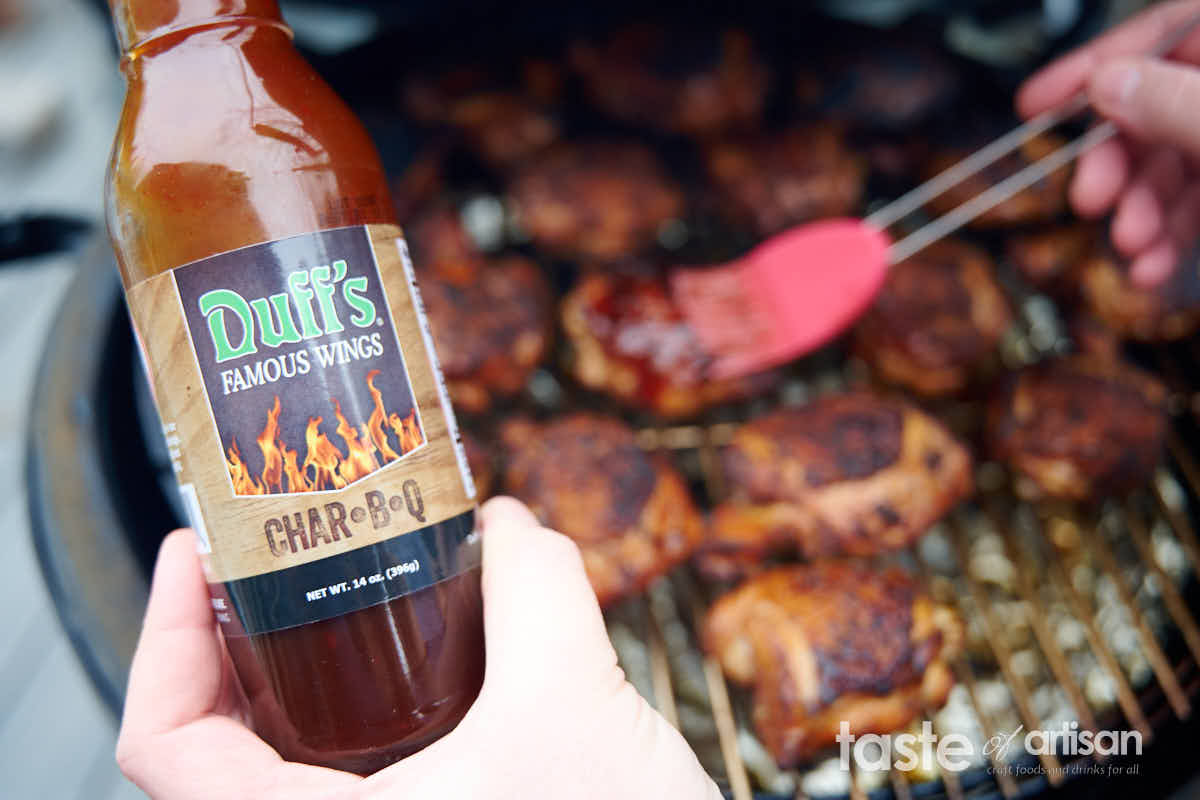
Serving
This is it, the chicken is ready. Insanely juicy and moist inside.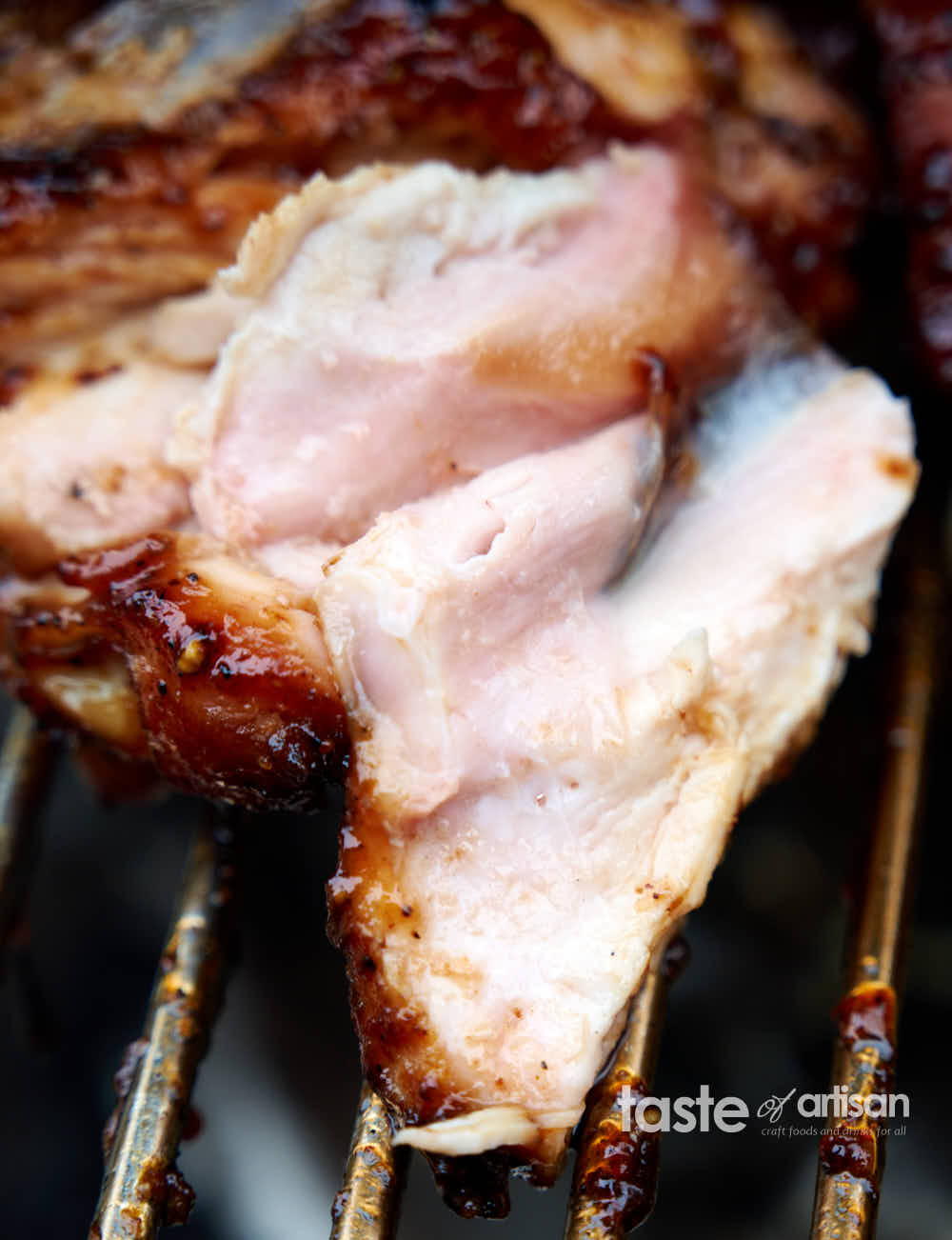
Transfer it to a serving platter and let rest for 5 minutes. This will allow the meat fibers to relax and re-absorb some of the lost juices. This step will make the chicken stay moist and juicy for much longer.
Enjoy!
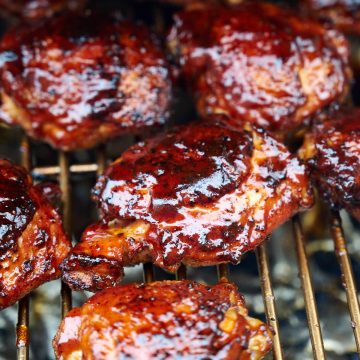
Smoked Chicken Thighs (Crispy Skin, BBQ Glazed)
Print Pin RateIngredients
- 8 chicken thighs bone-in, skin-on
- 1 tsp vegetable oil
- 1/3 cup BBQ sauce plus more as needed
For the chicken rub
- 1 tsp kosher salt or to taste
- 1 tsp black pepper or to taste
- 1 Tbsp granulated garlic
- 1 Tbsp granulated onion
- 1 Tbsp sweet paprika
- 1/4 tsp ground coriander
- 1/4 tsp dried marjoram leaves
- 1/4 tsp cayenne pepper optional; use if you want mild heat. Add more of you want more heat.
For pan-searing
- 1/4 cup cooking oil
- 1/4 cup butter
Instructions
- Preheat smoker to 250F - 275F at the grate level.
- Combine the rub ingredients in a small bowl and set aside.
- Rub chicken thighs with oil and apply the rub evenly on both sides of each chicken piece. Get some seasonings under the skin. Pat down to make the seasonings stick. Let rest in the fridge for half an hour and up to 2 hours. You can even leave them in the fridge overnight.
- In a large cast iron skillet, heat cooking oil and butter over medium-high heat. In two batches, sear the chicken thighs skin side down, about 2 minutes or until the skin is golden brown. You don't need to sear the skinless side.
- Transfer the chicken to the smoker, skin side up.
- Smoke at 250F-275F over indirect heat for about 1 - 1.5 hours, or until the internal temperature reaches 185F to 190F.
- Just before the chicken reaches the target temperature, glaze it with BBQ sauce and smoke for another 15-20 minutes to let the sauce set.
- Remove the chicken from the smoker, let rest for 5 minutes, then serve.
Nutrition


Shawn says
This is my go-to smoked/BBQ'd chicken recipe. While I don't necessarily measure out the ingredients exactly (I like it heavily seasoned), I follow the spirit of it very closely. The coriander and marjoram are spices I seldom use but they are perfect here. I believe it's tasty enough on it's own that I almost never add BBQ sauce. I like to give it a quick 'crisp-up' in the oven or BBQ after.
Victor @ Taste of Artisan says
Glad to hear it, Shawn. Another spice I recently discovered for myself is Lovage. I just love the flavor of it. Use it on my chicken a lot lately. Enjoy!
Steve says
Excellent recipe. Have not tried searing before smoking and it was fantastic. Seasoned up and fridge for 2 hours. Seared on electric stove top with cast iron skillet. Smoked mine for about 2 hours with mesquite.
My smoker is a little cheaper electric so it only goes to 275 max and has trouble maintaining that max level of heat when loaded up. Two hours got me to around 160ish and I finished in the oven on 450 to crisp up the skin just a bit more and get me to 180-190. Plenty of smoke flavor and best tasting I've made.
Will have to give your rub a try. I used stuff I had this go around. Meat was not too salty or sweet (used a variety) of rubs. Very juicy meat and crispy skin. Tiny bit of char on the skin with the sweeter rubs but not bad. Will be my go to for smoking chicken going forward.
Victor @ Taste of Artisan says
Glad to hear it, Steve. Enjoy!
Clayton says
I like the process! Will have to try it.
Numerous authorities and studies have shown that the only thing that penetrates meat - is salt and water (in a brine), but little else. You might get some flavoring on the outside from a wet brine or a dry rub but it isn't going to penetrate the meat.
Perhaps starting with salt, resting an hour, then searing. Once your skin is nicely rendered, pull, add your seasonings, and bring it to the smoker. Most rubs have sugar and that will reduce the chances of burning the skin during the searing process.
Victor @ Taste of Artisan says
Clayton, that's interesting, so these studies say that nothing that is diluted in water other than salt will penetrate? It's hard for me to buy into that. I steep carrots, garlic, onions, herbs, and spices in a hot brine, which saturates the brine water with various aromatic micro elements. My taste buds say the meat inside is flavored when I bite into it;) Dry rubs are a little different. True, most of the flavoring elements will stay on the surface, but some of the salt will melt and get absorbed by the meat. It makes a huge difference between biting into bland meat vs salted meat. Meat is like a sponge, it absorbs water. Salt draws water out of meat, which then mixes with salt and water-soluluble aromatic elements. That water than gets re-absorbed back into meat. It's a slow process. The longer you let the meat sit in the fridge, the more of that salt/aromatic elements will get absorbed by it, and the deeper it will get absorbed. I trust my tastebuds. Enjoy!